Brief
 }
}
Apple, eBay, ING Direct. It’s no coincidence that these companies enjoy enviable financial results, have growing bases of zealous customers and routinely deliver outstanding experiences to customers. Providing a great experience fosters deep advocacy and leads to strong economics because loyal customers tend to buy more, stay longer, refer their friends and cost less to serve. This loyalty can be tracked using Bain’s Net Promoter SystemSM, which calculates a company’s Net Promoter ScoreSM. (A company’s Net Promoter Score, or NPS®, measures customer loyalty based on a simple metric: the likelihood that customers will recommend the company to their friends or colleagues.)
Many executives trace the strength of their customer experience directly to customer service. By this logic, earning greater loyalty requires improving individual service interactions. However, recent Bain & Company analysis suggests that customer advocacy stems from many elements beyond service alone. In a survey of more than 6,000 Australian consumers across 10 industries within the financial services, telecommunications (telco), utilities and insurance sectors, respondents clearly indicated that they consider a wide range of experiential and non-experiential elements—not just customer service—when evaluating their experience with a company.
When asked what makes them most likely to recommend a company, customers who are promoters cited not only service, but also their experience using the products, the price or value of the products, and the company’s reputation and brand image (see Figure 1). The relative importance of attributes varied by industry (for example, the user experience was most important in industries like home broadband, where it’s a core part of the overall experience), but responses from all industries consistently show that earning loyalty requires more than just good customer service.
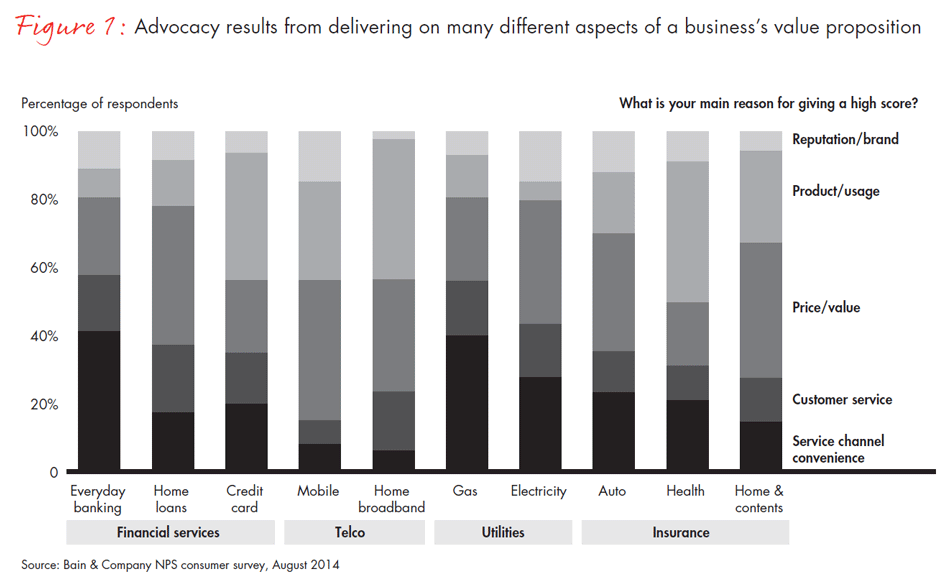
Five imperatives
Our analysis, combined with the experiences of loyalty leaders, suggests five imperatives to focus on to create an exemplary customer experience:
- Examine the experience from the outside in. The customer’s point of view, not the organisation’s structure and processes, should define the customer experience.
- Meet customer expectations consistently. Earn the right to differentiate by first offering consistent performance and eliminating failure points.
- Differentiate where it matters most. Invest to provide outstanding experiences in the areas that have the greatest impact on customer advocacy.
- Test, fail fast and learn. Use rapid prototypes to deliver new services to customers—incorporating left-brain and right-brain design principles and cross-functional teams—and use those engagements to better understand what customers want in a given interaction.
- Never stop improving. Develop closed-loop feedback processes, continuously refining experiences to match or exceed ever-rising customer expectations.
With these imperatives as a guide, loyalty leaders have been able to deliver customer experiences that earn greater loyalty and thereby establish a platform for strong, sustained growth.
Imperative 1: Examine the experience from the outside in. When it comes to evaluating and improving the customer experience, many companies are constrained by their organisational structures. They perceive customer experience through their own lens of internal functions and processes—product design, operations, sales, IT, customer service and so forth. Yet customers don’t care about the company’s structure. They evaluate their experience based on whether the company is able to address their needs: Was I able to download the movie I wanted? Get a telephone representative to help me resolve my insurance claim? Use my smartphone to check the balance on my savings account?
From this perspective, any one interaction with a company may help address the customer’s needs, but it’s not the full picture. (Similarly, many companies try to improve the customer experience by addressing specific pain points. This approach often leads to small-scale improvements, but it doesn’t move the needle on the overall experience.) It’s more useful to think of the whole process of meeting a need as a single “episode.” The customer defines episodes—they begin when the customer expresses a need, encompass all activities required to meet that need and do not end until the need is met. The entertainment industry provides a good analogy: The company is putting on a performance (the episode) for the benefit of an audience (the customer) and all staff have to coordinate—both onstage and off (frontline and back-office employees)—to ensure that the experience is right. Moreover, episodes are usually short in duration, allowing the company to create high-velocity learning loops that identify issues right away.
Consider a customer who wants a home broadband plan after moving into a new apartment (see Figure 2). This may require several steps, from contacting the provider’s call centre, to receiving a modem in the mail, to interacting with a field technician and more—all before the customer can actually use the service. While the broadband provider may be tempted to measure the customer experience after any one of these steps, the episode doesn’t end until the customer’s Internet is up and running. This customer-needs-based definition of episodes is critical because many interactions within an episode influence the customer’s overall perception of that episode. For example, a positive interaction with a helpful call centre representative at the beginning of an episode could be later offset by a fulfilment delay or a processing mistake, undermining the whole experience and eroding loyalty.
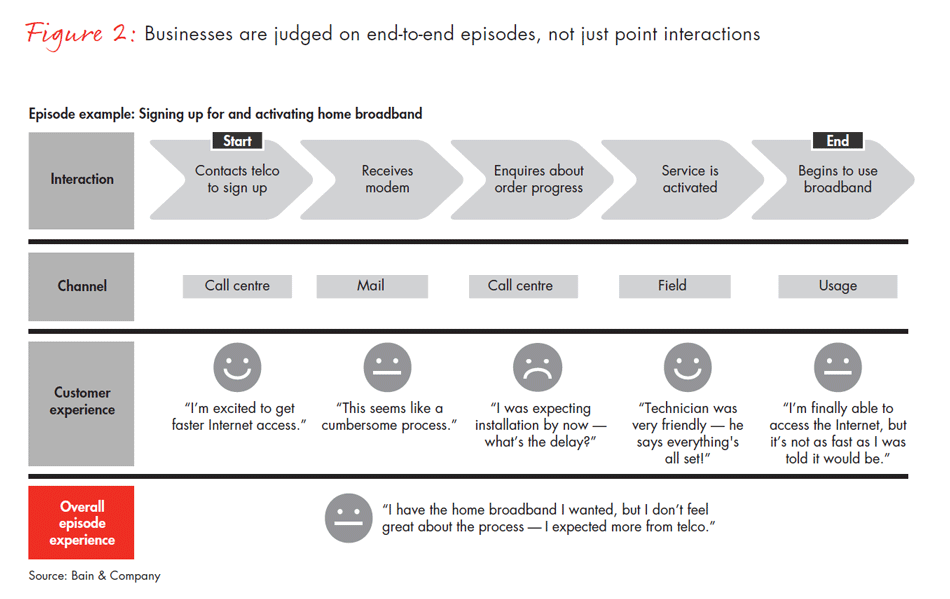
To understand the relationship between episodes and interactions better, one leading telecommunications provider measures loyalty for both. When the company receives its customer feedback, it consistently sees that comprehensive episodes receive lower NPS than individual component interactions (see Figure 3). The message is clear: In order to improve an experience, companies must look beyond individual interactions to consider the entire episode.
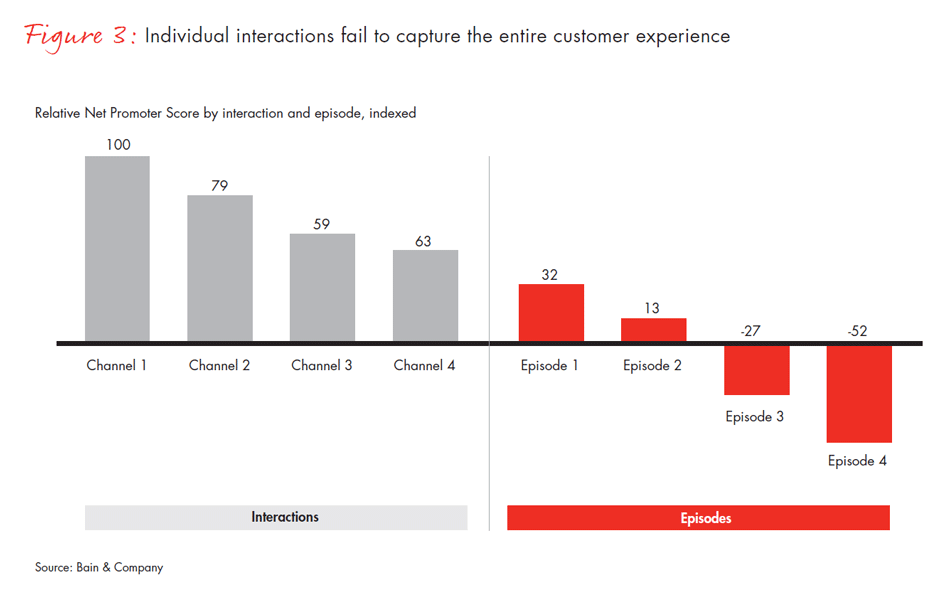
Imperative 2: Meet customer expectations consistently. With a firm understanding of its customers’ episodes, a company can begin investing in an outstanding experience. But how should it prioritise and sequence its investments to accomplish that goal?
Executives may be tempted to focus first on the episodes most likely to become highly distinctive, but the experiences of loyalty leaders suggest another approach. First, create a base level of consistent performance across the customer experience—by prioritising and upgrading the episodes with the worst performance, or those that affect the highest number of high-value customers—then create points of differentiation. To be sure, certain episodes, when improved, will be more likely to create promoters, but a company is unlikely to achieve this differentiation if it fails to reliably meet basic needs. Eliminating flaws in the experience starts by identifying points of friction within episodes. Customers usually have clear views about how the basic aspects of a company’s offering should work, and when their expectations aren’t met, they will voice their dissatisfaction. Outright failures such as lost orders and incorrect payments processing, or recurring nuisances like unfriendly staff or unreliable websites, can undermine the experience on a daily basis, making it nearly impossible for the company to delight its customers elsewhere.
One global retail bank has worked hard to create a consistent and welcoming environment in its branches as a foundation for more distinctive elements of its experience. Specifically, it started perfecting the basics of customer service by ensuring that tellers greet the customer, make eye contact, use the customer’s name, offer further help and thank them for their business. In this way, the bank has achieved a baseline of consistent performance in regular, everyday interactions. The effort has led to significantly higher customer perceptions of service levels, forming the basis for further differentiation in areas such as replacing lost or stolen cards, or making international payments.
Imperative 3: Differentiate where it matters most. Amidst the many episodes customers engage in, certain ones tend to stand out in their minds and influence their advocacy for a company. Not surprisingly, when companies excel in these “moments of truth,” they are rewarded with strong loyalty. In fact, in every industry we analysed, companies with the highest NPS in their industry also outperformed the average on those episodes that customers deemed most important (see Figure 4).
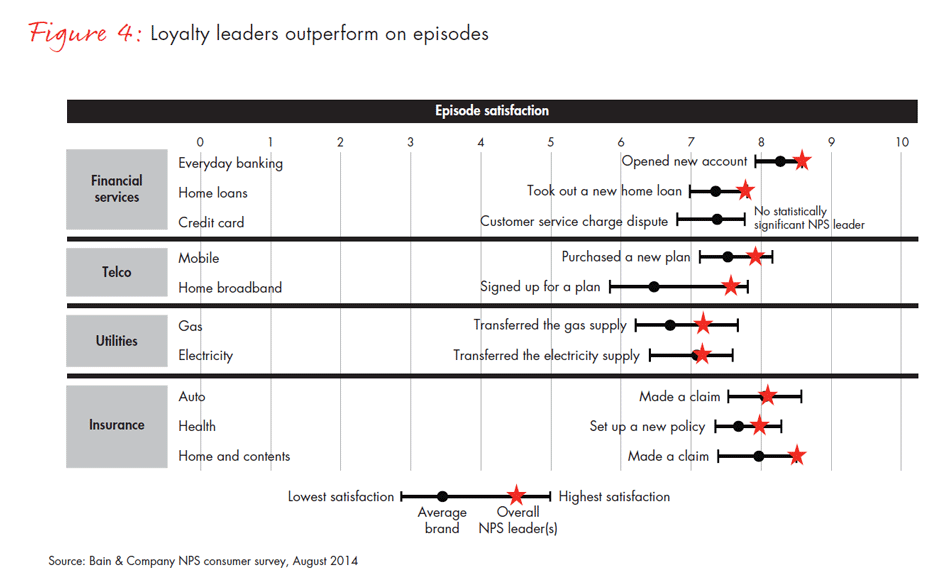
Identifying these key episodes requires understanding each episode’s potential to delight and to anger.
Consider gas utility customer episodes. When surveyed about recent experiences with their gas provider, customers indicated that transferring existing gas service to a new home had a high potential to delight when the episode went well and a moderate potential to anger when it didn’t (see Figure 5). As a result, transferring service was the episode with the highest overall impact for these gas customers—a clear opportunity for a provider to distinguish itself. This finding makes intuitive sense: Currently, transferring service is often a complex process that requires multiple points of interaction with the provider, and it occurs at a stressful time, when customers are packing and handling many other logistical details. If there are glitches, it becomes one more hassle stacked on a mountain of others—fuelling the customer’s annoyance. Yet when the episode goes smoothly, it can be a bright spot of simplicity.
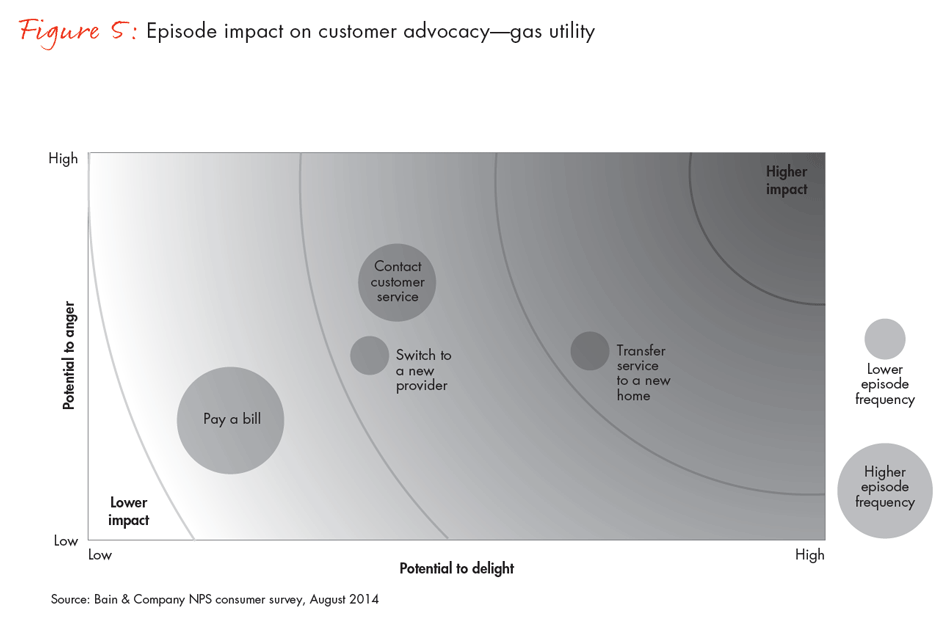
Given this, a gas utility looking to delight its customers should seek to create a seamless transfer experience: simple, straightforward processes; strict timelines; and smooth behind-the-scenes interactions among different business functions.
Comparing episodes across industries can further help companies identify opportunities for performance improvement. While the overall importance of most episodes holds fairly constant across the 10 industries we examined (paying a bill always has a lower total impact, while setting up an account has a consistently higher impact), companies’ ability to delight or anger customers on these episodes varies considerably.
Setting up a new account, for instance, has three distinct clusters of performance in terms of their impact on advocacy overall (see Figure 6):
- Complicated set-up. Industries such as gas retail and home broadband that have lengthy and complex processes, often coupled with residential moves, have lower potential to delight and a greater potential to anger customers.
- Straightforward set-up. Industries such as credit cards and mobile phone service, with relatively simpler processes, have moderate potential to delight and anger.
- The complex made simple. Surprisingly, our analysis found that retail banking account set-up has a high potential to delight and low potential to anger. One would expect the potential-to-delight impact to be lower (and it used to be at the same level as gas and electric utilities), primarily because the set-up process can often involve multiple accounts, such as checking, savings and credit cards. But banks have made considerable recent investments in new processes and channels to facilitate this episode, and they have improved the utility of their products by adding new features and services through online banking (see below, “Making the most of digital channels”).
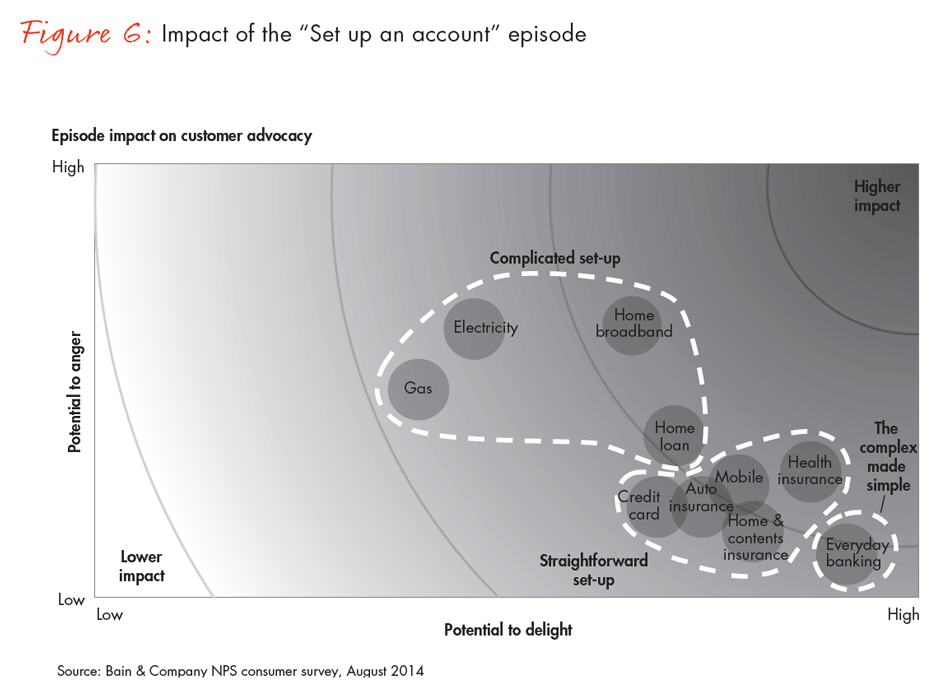
For companies at the low end of any of these clusters, stronger performers may offer key insights on where to improve processes. And, for almost all organisations looking to strengthen their account set-up process, everyday banking likely offers lessons in how to gain an edge in an episode that our analysis shows has a big influence on loyalty.
Imperative 4: Test, fail fast and learn. Every company, regardless of industry, should seek to better understand its customers—their wants, their needs and the problems that irk them—and then actively design a better customer experience. Improving the experience requires three specific aspects: (1) a combination of left-brain and right-brain design, (2) a cross-functional team and (3) rapid prototyping and rollout.
For example, one global bank looking to gain a meaningful NPS advantage over its competitors set out to create signature experiences on key episodes like credit-card applications. To redesign the application episode to impress customers, the bank assembled a diverse team—marketing, IT, customer service and others. The team then laid out a comprehensive storyboard for the episode, mapping out each step in the process, including what the customer would be thinking and feeling as she researched, applied for and received her credit card. Based on storyboarding insights, the team developed a set of goals that would create meaningful differentiation if the bank could meet them, such as an application taking less than 90 seconds to complete and the ability to begin shopping before a customer receives the physical card.
Moreover, experience design at this level is only half of the equation. The other half is internal: Companies must design the way that they deliver the experience, through organisational elements to support the new customer episode—at scale. Just as the first aspect requires deep, immersive research into customers, the second aspect requires creating a cross-functional team of employees that can collaborate on various aspects of the episode to deliver it consistently. Companies must also learn to analyse their performance in order to improve that performance over time. Episodes often span many parts of a company, and the teams tasked with improving them should reflect this functional diversity. With a team comprised of all groups involved in a particular episode, the design process can move more quickly, identify more possible solutions and more comprehensively anticipate and overcome roadblocks to a scalable solution.
Speed is also critical. Gone are the days when a comprehensive customer experience could be designed over a lengthy (sometimes even multiyear) period before being rolled out to customers. Today, many companies are drawing inspiration from the rapid prototyping that digital companies use successfully, yet larger companies in other industries are experiencing mixed results. The right approach requires identifying which elements will be prototyped (the entire episode or specific components), in what sequence (complex episodes often involve a dozen or more distinct prototype activities) and through which techniques.
Moreover, companies should be explicit about their objectives in prototyping. Many companies set up a prototype simply to prove its feasibility to senior executives and the board of directors—under artificially ideal conditions—only to run into trouble when asked to roll it out at scale. By contrast, an agile company will use an iterative development process in which it makes changes quickly and gets customer feedback on them, while also working through the systems and process changes needed for a full rollout.
The right approach develops and tests prototypes using deep customer insight and cross-functional teams. Rapid development cycles take weeks and months, not quarters and years. Initiatives move from development to pilot-testing as quickly as possible. Project teams understand that the first “answer” and the second, and perhaps even later iterations, tend not to be final. Rather than aiming for the perfect solution on Day One, companies should aim to create prototypes of the redesigned episode that can be tested with customers to fuel an iterative learning process.
The bank mentioned above used this kind of rapid deployment process to implement the credit-card application episode it developed through storyboarding. Rather than trying to perfect the episode through the internal development process, it rolled out key features quickly, tested them with customers, refined them, tested them again to ensure they would deliver the maximum possible impact and then finalised them into a recommended redesign. Through this iterative approach, the bank was able to design a highly distinctive episode and have it ready for scale development in months instead of quarters—a vast improvement over previous efforts.
Imperative 5: Never stop improving. Customers’ needs, desires and expectations change constantly, and the quality of customer experience must keep pace. Companies can keep the experience relevant by continually assessing what matters most to customers and adjusting accordingly. A regular feedback loop will keep the voice of the customer front and centre. Many loyalty leaders have found that the Net Promoter System provides a holistic way of aligning operations around customer feedback. NPS practitioners have created sophisticated systems that enable them to close the loop with customers, bring the comments and criticisms that they get to the front line and, through individual coaching and team huddles, use that feedback to continually improve the experience. They can also tie it to their financial systems, giving executives a crystal-clear picture of the economics of loyalty. In addition, by keeping close to the customer, organisations can quickly pick up on trends that may signal new opportunities to expand or retain their advantage on key episodes (see the Bain Brief “Introducing the Net Promoter System”).
Ultimately, earning loyalty hinges on excelling where it matters most to customers. By taking the customer’s point of view in defining the experience, aiming for consistency in meeting customer expectations, targeting episodes that have the greatest effect on advocacy, designing new solutions in an agile manner and continuously improving processes, companies can lay the groundwork for deep loyalty and strong growth for years to come.
Katrina Bradley and Richard Hatherall are Sydney-based partners in Bain & Company’s Asia-Pacific Customer Strategy & Marketing practice.
Making the most of digital channels
Increasingly, digital channels (particularly mobile apps, which have grown exponentially in recent years) offer opportunities not only to reduce the cost and time of delivering basic interactions, but also to excel in critical, advocacy-defining episodes. Indeed, customers who frequently use digital channels give an NPS on average 10 to 20 points higher than customers who don’t use digital.
Commonwealth Bank of Australia (CBA) offers a prime example. Looking to make a step change in its advocacy, CBA introduced a suite of digital innovations to create compelling points of differentiation. One innovation was its “Property Guide” app, which supports customers in the initial steps of getting a home loan (a key episode in the home loan industry) by enabling real estate searches, providing property valuations and sales histories, calculating monthly payments and putting buyers in contact with agents and lenders. CBA’s digital efforts exceeded expectations—in less than a decade, the bank improved from one of the worst performers in terms of overall satisfaction to the best bank in Australia and saw its share price rise over 80%. (See Darrell Rigby, “Digital-Physical Mashups,” Harvard Business Review, September 2014.)
Net Promoter® and NPS® are registered trademarks of Bain & Company, Inc., Fred Reichheld and Satmetrix Systems, Inc.Net Promoter SystemSM and Net Promoter ScoreSM are trademarks of Bain & Company, Inc., Fred Reichheld and Satmetrix Systems, Inc. Results Delivery® is a registered trademark of Bain & Company, Inc.





